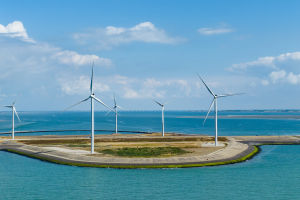On the vast ocean, enormous wind turbines stand tall across the expansive sea, symbolizing modern engineering innovation and humanity's significant step toward sustainable development.
As the global climate crisis intensifies, the demand for clean energy grows.
Offshore wind power, a green energy source on the rise, is rapidly gaining popularity worldwide due to its low-carbon, efficient, and environmentally friendly advantages. It is becoming an integral part of the green energy revolution.
Offshore wind power has garnered attention mainly because of its distinct advantages over onshore wind energy. The sea provides a strong and stable wind resource, free from obstacles like mountains or buildings, allowing wind turbines to operate more efficiently.
Moreover, offshore wind farms are situated far from urban areas, reducing noise pollution and minimizing environmental disturbances, enabling harmonious coexistence with nature.
This environmentally friendly quality has led many countries to invest in and promote the development and construction of offshore wind farms.
The development of offshore wind energy is not only a technical innovation but also a win-win for both environmental protection and economic growth.
Unlike traditional thermal power generation, which emits substantial greenhouse gases, offshore wind power generates no harmful emissions, making it a genuinely zero-carbon energy source.
By harnessing natural resources for power generation, offshore wind farms can make a significant annual contribution to reducing greenhouse gas emissions while decreasing dependence on fossil fuels.
Additionally, offshore wind farm construction has spurred the rise of emerging industries, providing abundant employment opportunities and research prospects in fields like engineering design, material science, and marine ecological protection.
Despite the many advantages of offshore wind power, its construction and operation face several challenges. Firstly, building an offshore wind farm incurs a much higher construction cost than onshore wind farms, especially in deep-sea areas where technological requirements and maintenance costs are relatively high.
However, with technological advancements and increasing economies of scale, the cost of offshore wind power is gradually decreasing, and many governments are supporting its development through policy support and subsidies.
Secondly, the potential impact of offshore wind farms on marine ecosystems requires special attention. For instance, wind turbine operations may affect fish populations and marine mammals, particularly during the construction phase, where activities like piling may disrupt the ecological balance of the seabed.
To address this, countries often conduct thorough environmental assessments during offshore wind development and implement measures to minimize impacts on marine ecosystems.
Currently, European countries lead in the offshore wind sector, especially the United Kingdom and Germany, which have established large-scale offshore wind farms supplying a significant portion of their electricity.
For example, the UK's North Sea offshore wind farms provide clean power to millions of households, setting a benchmark for offshore wind energy in Europe. As a major global energy consumer, China is also accelerating its offshore wind expansion, advancing the field through technological innovation and policy support.
In the future, as energy storage technology advances and smart grids become more widespread, the efficiency of offshore wind power will further increase.
Improvements in energy storage will allow wind farms to store power during low wind speeds and release it during peak consumption, creating a more stable energy supply.
Additionally, integrating with smart grids will enable offshore wind power to be better incorporated into national power systems, reducing reliance on traditional energy sources and supporting a low-carbon economy.
Offshore wind power provides a path toward a green future with immense potential for humanity. Despite the challenges, offshore wind energy, with its advantages in power supply, environmental protection, and industry innovation, has become a central force in the renewable energy field.
In the future, as technology progresses and environmental awareness grows, offshore wind power will continue to expand, contributing to the creation of a greener planet.


